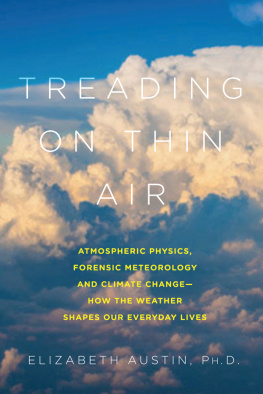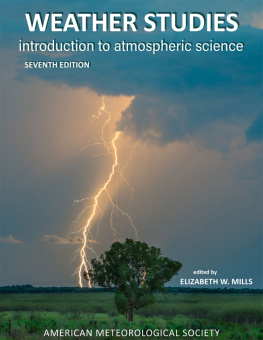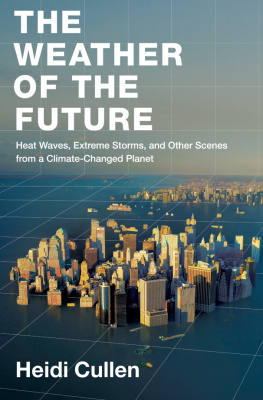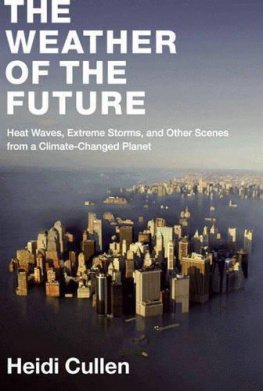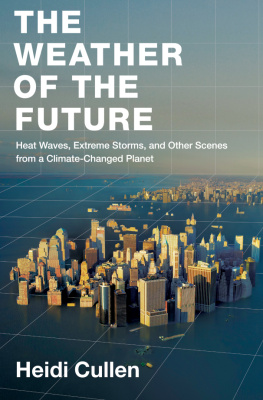
TREADING ON THIN AIR
Atmospheric Physics, Forensic Meteorology, and Climate Change:
How Weather Shapes Our Everyday Lives
ELIZABETH AUSTIN, P H. D.

TREADING ON THIN AIR
Pegasus Books Ltd.
80 Broad Street, 5th Floor
New York, NY 10004
Copyright 2016 by Dr. Elizabeth Austin
First Pegasus Books cloth edition April 2016
Interior design by Maria Fernandez
All rights reserved. No part of this book may be reproduced in whole or in part without written permission from the publisher, except by reviewers who may quote brief excerpts in connection with a review in a newspaper, magazine, or electronic publication; nor may any part of this book be reproduced, stored in a retrieval system, or transmitted in any form or by any means electronic, mechanical, photocopying, recording, or other, without written permission from the publisher.
Library of Congress Cataloging-in-Publication Data is available.
ISBN: 978-1-60598-822-1
ISBN: 978-1-60598-823-8 (e-book)
Distributed by W. W. Norton & Company
For my family...
My loving and supportive husband, Alan Austin
Our son, nuestro Angelito, Evan
My sister, Greer, and brother, Patrick
And my parents, Catherine and Patrick Williams
CONTENTS
TREADING ON THIN AIR
I wrote this book from my memories, notes, articles, and research. As some of the events go back many decades, my memories have faded. I tried to recall all people, names, and facts to the best of my knowledge. I did not change any names, and all events are true to my recollections. This book is not intended to be a purely scientific book nor a standard memoir but a unique combination to give the reader a journey through the world of weather and climate through my eyes.
I think the age of exploration is just beginning, not ending, on our planet.
Robert Ballard
W hats the most dangerous thing you have ever done, Einar? the reporter asked. Was it flying a jet fighter in the U.S. Air Force, as a test pilot for NASA, for Grob, for the Royal Air Force, or was it trying to set the world altitude record in the Perlan glider with Steve Fossett? Without hesitating, pilot Einar Enevoldson replied, delivering his response in an incredibly understated voice, as if he were making an observation about a move in a chess match, Oh, flying the Perlan to altitude, he said, as if he were merely summarizing what he had eaten for lunch that day. Ive found that most pilots of this caliber usually dont have a shred of Hollywood melodrama about themselves when it comes to describing their incredible, often extremely dangerous, feats.

It was a dark and very cold winter morning in August 2002 in the small town of Omarama, New Zealand. Omarama is on the South Island of New Zealand and is in the lee of the Southern Alps in central Otago province. Omarama, which in Mori means place of light, has some of the clearest skies I have ever seen. Omarama is so small, its almost not a town. The population is just over two hundred souls and, on this occasion, our Perlan team had essentially taken over the place. The team members were buzzing around the one grass runway at the airport, busy making all the preparations in an attempt to break the world altitude record for a manned glider. The press was everywhere with cameras rolling as they interviewed various people from our team. The locals were chatting away and some volunteers were doing their best to keep the people and press in their designated areas. I was one of the team members giving interviews to the media as well, as I was the chief meteorologist on the project. Television production company Natural History New Zealand (NHNZ) got wind of the project and found it interesting enough to come and do an on-camera interview with me, too. Little did most of the interviewers know that our team had already spent years getting to this point in the project, a fact that would soon be revealed, however, as they got their stories out of various members of the team.
The glider built for the Perlan mission is special, as it does not have an engine and, unlike most gliders, is designed for high-altitude flight. Some gliders carry one pilot and others two pilots. Our Perlan glider carries two pilots. It has a tremendously long wingspan in order to facilitate flight to very high altitudes. Gliders are also inherently strong, as they must be able to withstand tremendous turbulence when flown in mountainous regions where turbulence can hide in plain sight, so to speak. The Perlan Glider is built to withstand 8 gs or eight times the force of gravity at sea level.
The locals turned out to see what the crazy Americans were doing in the wintertime soaring a glider in the mountains, and most of the press were there because Steve Fossett, the billionaire adventurer, was there to attempt another world record on the heels of his becoming the first person to fly around the world alone, nonstop in a balloon, covering 19,428 miles.
All of this commotion outside the glider was in stark contrast to the scene inside the cockpit of the experimental craft as Steve Fossett and Einar Enevoldson, who would be piloting the glider together, calmly completed their checklists. During the preflight time it was critical that they remained calm, as they didnt want to break a sweat in their space suits. This could have spelled disaster during the flight, since something as simple as perspiration could fog up their facemasks, making it impossible for them to see.
Checklist complete, Einar said to Steve.
Roger that, Steve replied through the microphone in the helmet of his pressure suit.
Mike Todd, our teams life support specialist, who was formerly with NASA, reached over to plug the gliders oxygen system into the pressure suits and then disconnect the external oxygen tanks the pilots had been using to breathe for the previous hour. Mike is an expert skydiver and parachute jumper who worked in the High Altitude Life Support and Pressure Suit Division of Lockheeds Skunk Works for almost thirty years.
Einar and Steve had been pre-breathing pure oxygen for the previous hour in their NASA/Air Force pressure suits. They are just like the space suits astronauts wear. Pre-breathing pure oxygen is a necessary protocol, whether you are about to perform a space walk outside the International Space Station or take a flight to high altitudes in an unpressurized aircraft while wearing these suitsjust as Einar and Steve were about to do. Pre-breathing pure oxygen washes out any excess nitrogen in the body prior to the flight. At altitudes above 50,000 feet a person, even one wearing a space suit like the ones Einar and Steve were wearing, requires pressurization because the atmospheric pressure is so low. In fact, above 55,000 feet a persons blood will literally boil if he or she does not have a pressure suit: low pressure changes the equilibrium pointthe point at which gas bubbles form in liquids, including blood. A rapid drop in pressure can result in caisson disease, known as the bends among the diving community. Caisson disease is the formation and expansion of nitrogen gas bubbles in the bloodstream when a person is exposed to a rapid drop in external pressurewhich was precisely what Steve and Einar were going to be exposed to while making this record attempt. Wearing the pressure suit enables the pilots to breathe by providing the necessary pressure (lungs dont function without positive pressurewhich is also why aircraft are pressurized), and breathing pure oxygen helps flush out the nitrogen that builds up in the blood.
Next page
